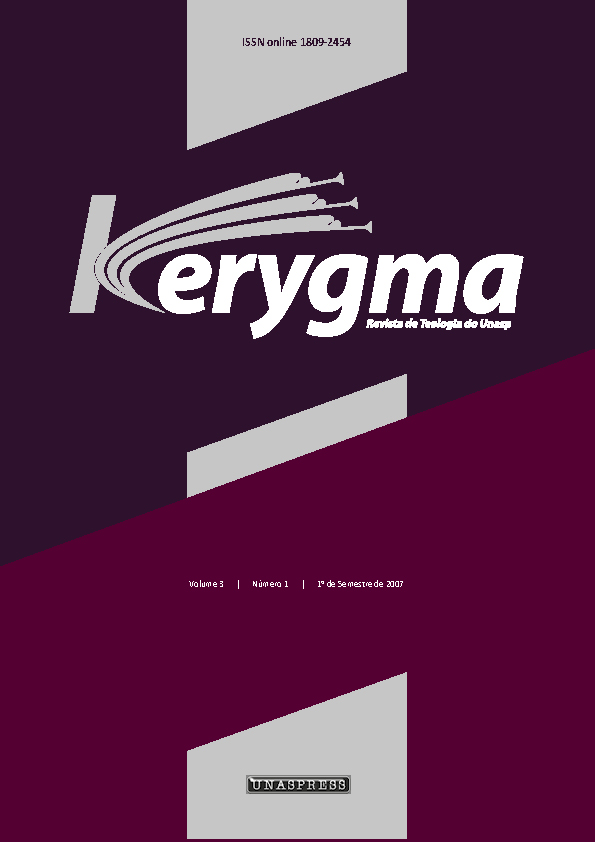Abstract
The goal of this research is to define what is a Greeting Ministry, how does it actually works in Adventist churches, to verify its relevance and to propose ideal Greeting Ministry models. The research implemented also a field research developed among some middle sized Adventist churches in the State of São Paulo, Brazil. The conclusions reached indicated that this kind of ministry has the function to integrate new members into the local community, as well as to promote between the general membership of the church a sense of belonging.
References
Gibbs, Eddie. I Believe in Church Growth. Grand Rapids/MI: William B. Eerdmans Publishing any, 1981.
Hadaway, C. Kirk. Church Growth Principles: separating fact from fiction. Nashville/TN: Broadman Press, 1991.
Laurie, Greg. A Igreja que Abala o Mundo. Trad. Célia Regina Chazanas Clavello. Campinas/SP: Editora United Press, 2002.
Logan, Robert E. Beyond Church Growth: actioRapids/MI: Baker Book House, 1989.
O Ministério de Recepção: coordenador. Artur Nogueira/SP: União Central Brasileira.
Parrott, Leslie. The Greeter’s Manual: a guide for warm-hearted churches. Grand Rapids/MI: Zondervan Publishing House, 1993.
Russell, Bob e Russell, Rusty. Umas Igreja de Sucesso: 10 princípios bíblicos testados e aprovados. Trad. Bruno G. Destefani. São Paulo: Sociedade Religiosa Edições Vida Nova, 2003.
Schaller Lyle E. Growing Plans: strategies to increase your church’s membership. Nashville/TN: Abington Press, 1983.
Weld, Wayne e McGavran, Donald A. Principles of Church Growth. Passadena/CA: William Carey Library, 1974.
White, Ellen G. Serviço Cristão. Santo André/SP: Casa Publicadora Brasileira, 1984.
Authors who publish on Kerygma must agree to the following terms:
- Once accepted for publication, the copyright of articles is automatically transferred to Kerygma.
- All material used in the text that is copyrighted by third parties must be duly referenced.
- Authors must also retain the reproduction rights of images and tables in their material, if necessary.
- The authors guarantee that the submitted text is entirely their authorship and has not been submitted and/or published elsewhere.
- The opinions, ideas and concepts expressed in the texts are the sole responsibility of their authors and do not necessarily represent the opinion of Kerygma;
- The editors reserve the right to make textual adjustments and adapt to the publication's norms.
- Authors retain copyright and grant the journal the right of first publication, with the work simultaneously licensed under Creative Commons Attribution-NonCommercial 4.0 International, which allows sharing of the work with acknowledgment of authorship and initial publication in this journal. This license allows others to remix, adapt, and build upon your work non-commercially, as long as they give proper credit to you and their new works are not used for commercial purposes. However, users are not required to license those derivative works under the same terms.
- The authors agree with the free reproduction of their material by Kerygma, which may adapt, modify, condense, summarize, reduce, compile, expand, alter, mix with other content, include images, graphics, digital objects, infographics and hyperlinks, illustrate, diagram, divide, update, translate and carry out any other transformations, requiring the participation or express authorization of the authors.
- The authors agree that Kerygma can distribute the articles through cable, fiber optics, satellite, airwaves or any other system that allows access to the user at a specific time and place, either by free channels or by systems that import payment. Kerygma may also include work in a physical or virtual database, archiving in printed format, storing on a computer, in a cloud system, microfilming and other current forms of archiving or that may still be developed, with or without profit.
- Authors are permitted to enter into separate, additional agreements for the non-exclusive distribution of the published version of the work in this journal (e.g., publishing it in an institutional repository or as a book chapter), with acknowledgment in the new publication of its initial publication in this journal.
- Kerygma owns the rights to all works published by it. The full reproduction of these texts in other publications, for any other purpose, by any means, requires written authorization from the publisher. The same goes for partial reproductions, such as summary, abstract, portions with more than 500 words of the text, tables, figures, illustrations, etc.
- Authors are granted permission and encouraged to publish and distribute their work online (e.g., in institutional repositories or on their personal websites) at any point before or during the editorial process. This is because it can lead to productive alterations and increase the impact and citation of the published work. (See "The effect of open access and downloads ('hits') on citation impact: a bibliography of studies.")

